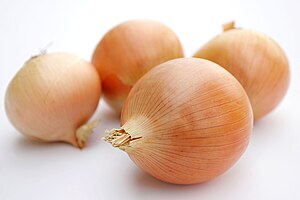Cookbook:Onion
| Onion | |
|---|---|
 | |
| Category | Vegetables |
Cookbook | Recipes | Ingredients | Equipment | Techniques | Cookbook Disambiguation Pages | Ingredients
Onion in the general sense can be used for any plant in the genus Allium but used without qualifiers usually means Allium cepa, also called the garden onion. Onions (usually but not exclusively the bulbs) are edible with a distinctive strong flavour and pungent odour which is mellowed by cooking. They generally have a papery outer skin over a fleshy, layered inner core. Used worldwide for culinary purposes, they come in a wide variety of forms and colors (but generally brown, white or purple).
The common brown onion tends to have a very pungent odour, and it makes the eyes water. Some varieties have more or less of the eye-watering chemicals, which also makes them taste milder. 'Spanish onions' (the large white onions with a purple skin and purple flecks) are much milder than brown onions, making them more suitable for raw use in salads.
Onions may be grown from seed or very commonly from "sets". Onion sets are produced by sowing seed very thickly one year, resulting in stunted plants which produce very small bulbs. These bulbs are very easy to set out and grow into mature bulbs the following year, but they have the reputation of producing a less durable bulb than onions grown directly from seed and thinned.
Either planting method may be used to produce spring onions or green onions, which are just onions harvested while immature, although "green onion" is also a common name for the welsh onion, Allium fistulosum which never produces dry bulbs and the 'Spring onions' used in Asian cooking are an entirely different variety which never grows a full bulb.
Preparing
editOnions may be either served raw or cooked. Cutting onions can be a harrowing experience and often bring tears to the eyes. Folklore says that burning a candle close to the cutting board may decrease the pain. Also, refrigerating onions for an hour or so beforehand will reduce crying and discomfort when cutting.
Onions have a pungent aroma. To remove the smell from hands simply rub hands on the surface of a stainless steel sink and rinse well. White vinegar can also be used to rinse hands, cutting boards, and other utensils to eliminate the onion smell.
Red onions have a milder flavor and may be safely added raw to dishes, most typically salads.
White and brown onions are best cooked. Boiling an onion only creates a bitter flavor, unless steps are taken to reverse the bitterness (boiling in salty water may help). Typically, onions are fried, usually in butter or oil in a skillet or frying pan. The time for which onions are fried before other ingredients are added varies in different cuisines; in Italian, onions are typically fried until translucent, while in Indian recipes, they are fried on a low heat until they are caramelized and turn brown, which produces a different flavour. It's best to fry onions with like vegetables -- garlic, leeks, or scallions. Cooking with acidic vegetables (e.g., tomatoes, tomatillos, or lemons) will disrupt the caramelization process and the onion will never soften. It's best to add acidic vegetables or wine (for deglazing) after the onions are soft.
Related species
editThe genus Allium is a large one, and most of the species are considered to be "onions" in the looser sense. Commonly raised vegetable alliums include the leeks, garlic, elephant garlic, chives, shallots, welsh onions and garlic chives.
The wild onion (allium ursinum) is collected in the wild, its leaves and bulbs used as food.